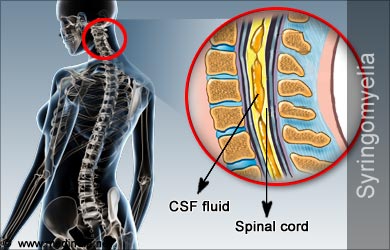- Syringomyelia Clinical Presentation - (http://emedicine.medscape.com/article/1151685-clinical)
- Syringomyelia and Syringobulbia - (http://www.patient.co.uk/doctor/syringomyelia-and-syringobulbia.htm)
About
Syringomyelia also known as hydromyelia is a rare neurological disorder where the person develops a fluid-filled cavity called syrinx in the spinal cord. This syrinx is usually formed in the neck region. It often enlarges and distends over time, damaging the nerve fibers that supply to different parts of the body, thereby causing a variety of symptoms.

Affected individuals may experience muscle stiffness and weakness, and pain. The patient may lose the ability to distinguish between hot and cold objects. These signs and symptoms may develop slowly and may vary from person-to-person. The progression of symptoms depends on the location of the syrinx in the spine and how much it expands over the time. It is absolutely necessary to treat the condition promptly in order to avoid serious neurological problems.
Syringomyelia is a rare disorder that is more common in men than women. Symptoms usually appear at the ages of 20-30 years.
What are the Causes of Syringomyelia?
The exact cause of syringomyelia is unclear; however it is believed to be caused due to the obstruction in the cerebrospinal fluid (CSF) flow.
In normal individuals, cerebrospinal fluid surrounds the brain and spinal cord and flows in its cavities. (The cavity of the spinal cord collapses after development). It is secreted by the blood vessels and reabsorbed into the blood. It acts as a cushion or shock absorber, protecting the brain and spinal cord from external shock and as a vehicle to supply nutrients and removes waste products.

Any obstruction that blocks the free flow of CSF results in accumulation of fluid just above the obstruction. This results in distention of the spinal cord, which later presses on the nerves and causes symptoms of syringomyelia.
Syringomyelia can be present from birth or arise later. Based on the time of origin, it is classified into two groups:
- Congenital Syringomyelia: This type of syringomyelia is present from birth. It is most commonly associated with a condition called Chiari malformation. In this condition, the brain tissue protrudes into the spinal region, thus obstructing the free flow of CSF. Other conditions like incomplete closing of embryonic neural tube, resulting in spinal cord abnormalities can also result in syringomyelia.

- Acquired Syringomyelia: Syringomyelia can also occur as a consequence of trauma, tumor, meningitis and arachnoiditis following infection, inflammation, bleeding or radiation treatment.
Conditions that are sometimes associated with syringomyelia are:
- Scoliosis: Scoliosis is a condition, where the spine is curved sideward. It usually occurs during growth just before puberty.
- Klippel-Feil syndrome: This is an abnormality characterized by fusion of any of the neck vertebrae, limiting the movement of neck.
- Horner’s syndrome: It is a disorder characterized by a drooping upper eyelid, constriction of the pupil, and absence of sweating and flushing of the affected side of the face.
What are the Symptoms of Syringomyelia?
Affected individuals develop symptoms slowly over the time. Syringomyelia associated with Chiari malformation may begin to show up with symptoms during teen years or early adulthood. In case of tumors or trauma, the symptoms may be triggered during coughing or straining activities.
The symptoms vary from patient to patient based on the location and the extent of nerves affected by the syrinx in the spinal cord. Symptoms include:
- Muscle weakness.
- Loss of reflexes and sensitivity to pain and temperature.
- Loss of position and vibration sense in the feet.
- Pain that is worse when a person touches the affected part like the neck, back and arms.
- Stiffness of back, shoulders, arms and legs.

- Sexual, bowel and bladder dysfunction.
- In due course, the patient may develop contraction of joints, curvature of spine (scoliosis) and osteoporosis.
How can we Diagnose Syringomyelia?
Diagnosis is based on:
- Complete patient history
- Physical examination
- Blood test to detect any infection or inflammation.
- MRI (Magnetic Resonance Imaging)

- CT-scan (Computed Tomography)
- X-Ray
How can Syringomyelia be Treated?
Syringomyelia interferes with daily activities. The main aim of treatment is to restore the normal flow of cerebrospinal fluid and to avoid neurological problems. In most of the cases of syringomyelia, surgery is found to be viable procedure.
Surgery for Syringomyelia is used:
- To correct abnormalities of brain structures (Chairi malformation)
- Drain the syrinx, using shunts if necessary.
- Remove the obstruction and restore the normal flow of cerebrospinal fluid.
The patient needs follow-up care as syringomyelia may recur. Hence, periodic check-up and examinations are necessary. Painkillers may be used to treat mild pain. Physical therapy may be advised in some cases.

Care is necessary to avoid activities that cause strain in the spinal cord and worsen the symptoms.







